Rounding out rental inventories with efficiency and versatility

Partner Content produced by KHL Content Studio
28 May 2024
Equipment rental continues to be an increasingly cost-effective solution for contractors as construction activity increases amid ever-tightening margins, and telescopic handlers are an ideal rental item due to their versatility and efficiency.
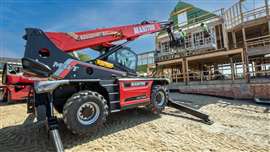 With a maximum capacity of 6 tonnes, the Manitou MRT 2660 has no trouble lifting an aerial work platform
With a maximum capacity of 6 tonnes, the Manitou MRT 2660 has no trouble lifting an aerial work platform
A close relative, the rotating telehandler can offer those same benefits, but with a twist (pun intended).
Telehandlers are the gold standard for lift-and-place capability, and when used with a wide variety of attachments, they can do it all on the jobsite.
Rotating telehandlers are no different, but instead of covering every inch of the work site, these machines spend most of their time stationary, lifting and placing materials from one location. As such, they can increase jobsite efficiency while saving on fuel costs.
With their versatility and the ability to do so many tasks from one small footprint, rotators are transforming the way construction is done.
“People who work in the construction industry are an innovative group, always looking for more efficient, safer, better practices for constructing buildings and putting things together, for getting their work done,” says Steve Kiskunas, product manager for telehandlers at Manitou.
“The reason a telescopic handler even exists is because 50 to 60 years ago, contractors were breaking their backs hauling materials up ladders to get their work done. They needed a rough-terrain, four-wheel drive, four-wheel steer powered tractor with a boom to place the materials instead of hauling it up by hand.”
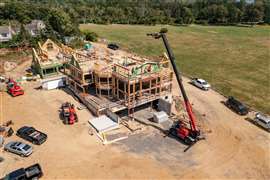 Manitou’s MRT 2660 has a maximum lifting height of 71ft 2in
Manitou’s MRT 2660 has a maximum lifting height of 71ft 2in
Things have come a long way since Manitou launched its first drive-and-place telehandler in 1981, followed by the rotating MRT 1540 in 1993. The West Bend, WI-based manufacturer now offers 11 rotators in its MRT Series, the largest with a maximum lift height of 113 feet and a max capacity of 15,400 pounds.
Rising focus on efficiency
As jobsite regulations become more stringent and construction practices advance, contractors are looking for machines that can get their job done efficiently. All the better if they can acquire that utility without the need to make an investment in owning the machine.
Rotating telehandlers are equipped with advanced features, including load management system, stability controls, and anti-collision technology.
“A rotating telehandler has a load management system that will stop the machine or any movement until it’s within the parameters of load operation,” says Rob Stanton, business development manager, MRT/MHT Central U.S.A. Manitou Group. “A traditional telehandler depends more on the expertise of the operator. For this reason, rotators can be ideal for less-seasoned users.”
Additionally, rotating telehandlers are designed for swift setup and easy maneuverability.
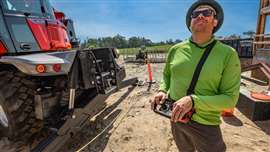 With the MRT series telehandlers, all static operations can be undertaken with the remote control unit
With the MRT series telehandlers, all static operations can be undertaken with the remote control unit
“We’re going to see even greater use of technology in making the equipment easier to use,” says Kiskunas. “More telescopic handlers will have guided information to help operators who perhaps are not as skilled as the ones they are replacing, to help them learn the equipment and to be able to operate it correctly.”
Kiskunas continues, “You’ll see that in some of our new standard machine designs, we have a software system with informational pop-ups that tell the operator exactly how to correctly operate the machine. For example, if it won’t move, the machine might make a simple prompt such as, ‘release the parking brake’ or ‘put the machine in neutral to start’ and so on.
“Rather than calling the rental company and asking to talk to the service department, the machine tells the operator the correct way it should be operated – and that includes safety warnings,” he explains.
Multi-tool capability
Rotating telehandlers are not yet a mature product, so there’s plenty of opportunity to tap into more uses and more ways for contractors to increase efficiency in their work. Much of that stems from the variety of attachments available.
“With different attachments being able to handle different tasks and materials, we have a great deal of customers looking to put our rotators to use in both construction and non-traditional applications outside of construction, such as industrial settings,” says Kiskunas. “Many of those industrial uses are heavily dependent on a specialized attachment.”
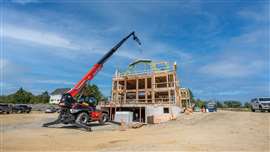 With a wide range of available attachments, rotating telehandlers can perform many tasks across different industries
With a wide range of available attachments, rotating telehandlers can perform many tasks across different industries
From buckets, forks and platforms to winches, hammers, and jibs, attachments enable rotating telehandlers to perform various tasks across different industries. The ability to switch between attachments quickly enhances equipment versatility, providing businesses the flexibility to meet multiple project requirements.
“There are regional preferences for the way buildings are constructed,” Kiskunas notes. “That’s going to tie into the type of fork carriages and the type of suspended load attachments operators will be looking at.”
He adds, “Attachments are going to drive your financial savings.”
Three-in-one machine
Manitou rotators are considered “three-in-one” machines because they can meet the same lift-and-place needs as traditional telehandlers, while also doing the work of a small boom crane when equipped with a lifting hook or jib attachment, or an aerial work platform when outfitted with a work platform attachment.
This affords renters more for their money while providing rental companies with a high-utility machine for maximum ROI.
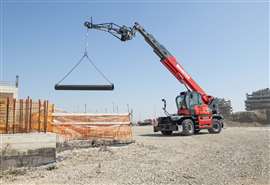
“The three-in-one machine concept really speaks to how renters can perform more tasks with a single piece of equipment, as opposed to spending the money to either rent or purchase other machines,” says Kiskunas.
“Rather than renting a dedicated aerial work platform with 1,000 pounds of platform capacity, for example, they can use a work platform attachment on a rotating telescopic handler and get 2,200 pounds of capacity, and then use that same machine for traditional lift-and-place tasks.
“And rather than renting a mobile crane, contractors can rent a jib with hook or a winch with hook attachment and work with suspended loads.”
Greener options
With sustainability becoming a global priority, the North American equipment rental industry is witnessing a shift toward more eco-friendly solutions while end-users are increasingly choosing rental companies that prioritize environmentally conscious equipment to meet their project requirements effectively.
Such machines can offer reduced noise levels, lower fuel consumption, and zero-emission operation, making them highly suitable for indoor and sensitive work environments. Manitou offers options to “go greener” with its rotating telehandlers.
“We’re offering three different ways to achieve zero or low emissions,” Kiskunas notes. “The first way is a standard, 680-volt battery back in the rotating machine.
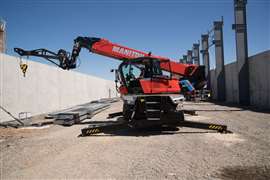 Manitou’s 100% electric MRT 2660e promises zero local emissions, low noise level and a long lifespan
Manitou’s 100% electric MRT 2660e promises zero local emissions, low noise level and a long lifespan
“The second option is to have a double-battery pack – or two 680-volt batteries – for a longer period of operation. And the third option is a 680-volt battery pack with a low-horsepower diesel engine to recharge that battery at the range extender – it’s not zero emissions, but it’s a very low-emission option.”
Kiskunas adds, “We expect it will be very popular in North America because we don’t have the zero-emission requirements that Europe does. But with that option, you can actually use the diesel engine to charge the battery if there isn’t a power source available on the jobsite.”
When the machine does need to achieve zero emissions, it can be easily converted by taking out the diesel engine and running on just the battery.
“The machine is designed so that the hybrid portion of the low-power diesel can be easily disconnected from the machine. Then if you want to operate it as a fully electric vehicle, just use your standard charger with a local power source,” Kiskunas explains.
Word is getting around about rotators
Rotating telescopic handlers are emerging as essential equipment for industries requiring efficient material handling, lifting and transportation capabilities. The growing demand for this versatile equipment, driven by increasing construction activities, industrial growth, and the need for efficiency, indicates a positive trend in the equipment rental industry.
The integration of advanced technologies, focus on sustainability, and customization options are further propelling the popularity of rotators. Keeping up with the evolving needs of businesses, rental companies are expanding their fleets to accommodate the rising demand for these versatile machines, ensuring smooth and cost-effective operations across various sectors.
“There are just a lot of applications for it,” Stanton concludes. “It enables users to stay engaged in one location a lot longer. The general contractors will get done building, then the stucco guys come in, then the painters… They can park the machine on one part of the building and stay engaged there without moving for a long time. It’s a real time saver.”
All images courtesy Manitou
This article was produced by KHL’s Content Studio, in partnership with experts from Manitou
CONNECT WITH THE TEAM





